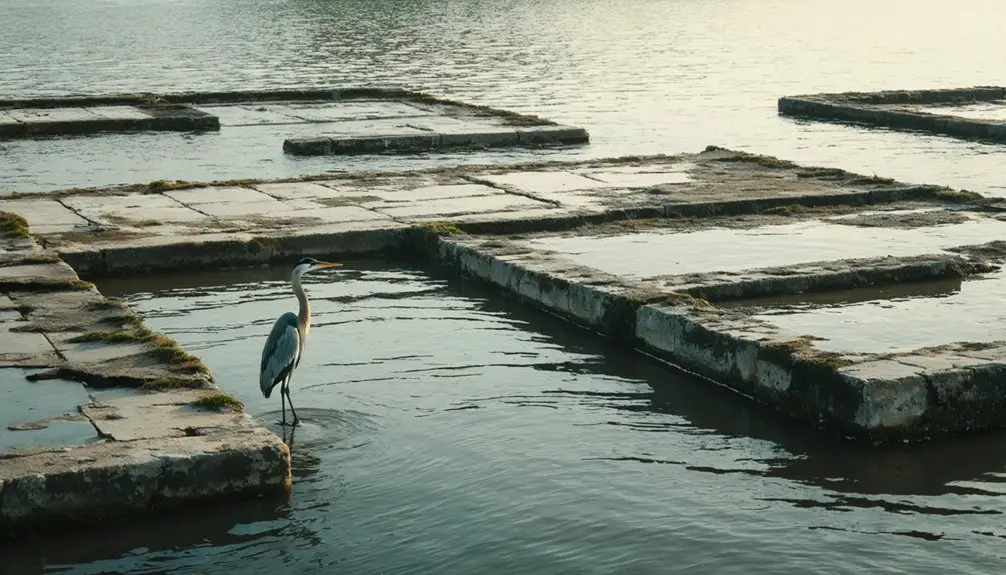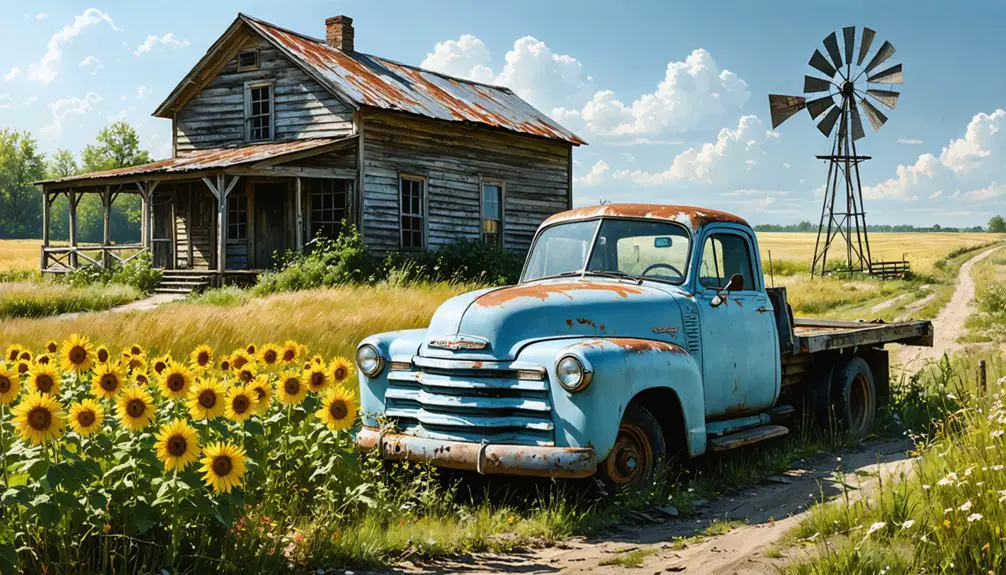You’ll find Washunga, Oklahoma beneath the waters of Kaw Lake today, but it was once the bustling headquarters of the Kaw Nation. Established in 1902, it served as the tribe’s central hub with a post office, school, and agency facilities. The town declined after the Kaw Agency’s closure in 1928, and by 1976, the rising waters of Kaw Lake submerged the remaining structures. The story of this submerged ghost town reveals a complex tale of tribal resilience and forced relocation.
Key Takeaways
- Washunga was established in 1902 as the Kaw tribe’s headquarters but became a ghost town after Kaw Lake’s construction in 1976.
- The town’s decline began with the Kaw Agency’s closure in 1928, leading to business failures and population decrease.
- Washunga’s original structures, including mills, schools, and tribal buildings, now lie submerged beneath Kaw Lake’s waters.
- The Flood Control Act of 1962 forced residents to abandon their homes and relocate 669 Kaw Indian graves.
- The town’s population dwindled from its peak to 100-150 residents by mid-century before complete abandonment due to dam construction.
The Birth of a Tribal Center
At the dawn of the twentieth century, Washunga emerged as the central headquarters of the Kaw tribe, marking a pivotal moment in their administrative history.
You’ll find the roots of this tribal center dating back to 1880 when a post office first opened at the Kaw Agency, though the town wouldn’t receive its name until 1902.
The establishment included 160 acres designated for essential tribal functions – a school, agency headquarters, and cemetery – plus 80 acres for the townsite itself.
Yet this development came with a steep price to tribal sovereignty. You’d have to sign a “Declaration of Competency” to own land individually, a policy that effectively dismantled the tribe’s legal status and challenged their cultural identity as a unified people. The Kaw Allotment Act of 1902 had already reduced tribal trust lands to just 260 acres.
By 1905, the Kanza population had dwindled significantly with only 90 full bloods remaining in the tribe.
Life in Early Washunga
Three essential structures formed the backbone of early Washunga life: a grist and sawmill for vital resources, a schoolhouse with dormitories for education, and the superintendent’s house representing federal oversight.
The Mississippi Valley Siouan culture deeply influenced daily village life in Washunga. You’d have found a community struggling to maintain its traditional practices while adapting to imposed changes. The Kaw people faced devastating health challenges, losing half their population to diseases between 1873-1879.
They’d worked to sustain themselves through livestock grazing on the tallgrass prairie, as the rocky terrain wasn’t suitable for farming. Despite external pressures, cultural resilience showed through their continued oral traditions and community bonds.
Life centered around dual-purpose buildings that served both administrative functions and tribal needs, while trading posts and mills supported basic economic activities within the settlement.
The Kaw Agency’s Role
When the Kaw Agency opened its doors in 1873 at the junction of the Arkansas River and Beaver Creek, it became the administrative heart of the Kaw Tribe’s new 100,137-acre reservation in present-day Kay County, Oklahoma.
You’d find a bustling center of tribal governance, complete with a mill, school, dormitory, barn, post office, and superintendent’s residence. The historic building features a distinctive native stone archway at its central entrance.
Under the leadership of Chief Washunga, who served as Chief Councilor from 1885, the agency managed crucial land leases to white ranchers and coordinated essential community services.
The agency’s role in cultural persistence remained strong until its closure in 1928.
While the reservation’s original acreage dwindled to just 13,261 acres by 1945, the agency building endures as the last intact structure, now preserved on the National Register of Historic Places.
A Community’s Gradual Decline
As you look at Washunga’s economic trajectory from the early 1900s to mid-century, you’ll notice a stark transformation from a bustling commercial center to a near-empty settlement of just 100-150 residents.
The Kaw Nation headquarters relocated to Oklahoma following this period of decline, reflecting the broader changes impacting the region.
You can trace this decline through the shuttering of grocery stores, service stations, and civic buildings that once served the community.
The closure of the Kaw Agency in 1928 marked a critical turning point, triggering a cascade of business closures that left only the primary school operating by 1950.
The town’s final chapter came when the Flood Control Act of 1962 led to the creation of Kaw Lake and the complete abandonment of the area.
Economic Activity Fades Away
The economic heartbeat of Washunga began to falter in the early 1900s, triggered by the far-reaching effects of the Dawes Act and the eventual closure of the Kaw Agency.
Like many other communities facing decline during that era, such as the Great Depression which devastated Sumner, Washunga’s economic stability eroded rapidly.
You’d have witnessed the community’s economic resilience tested as tribal landholdings shrank from 100,000 to just 13,261 acres by 1945, weakening the town’s financial foundation.
Similar to how railroad routing caused the decline of trade centers across Oklahoma, Washunga’s isolation from major transportation routes accelerated its downfall.
The stark reality of Washunga’s decline becomes clear through:
- The disappearance of local businesses, from grocery stores to the pool hall by 1950
- The loss of city government infrastructure that once supported a thriving community
- The steady exodus of residents as jobs vanished and commerce shifted to nearby Kaw City
Despite attempts at community adaptation, the closure of the Kaw Agency in 1928 proved devastating, removing the town’s primary economic engine and setting the stage for its eventual submersion beneath Kaw Lake.
Population Exodus Accelerates
Washunga’s economic decline triggered a steady stream of departing residents, marking the beginning of its transformation into a ghost town.
Population dynamics shifted dramatically as the Kaw Agency’s closure in 1928 prompted tribal landowners to sell their properties, weakening community resilience.
The Waters Rise: Kaw Lake’s Impact

Following authorization by the Flood Control Act of 1962, construction of Kaw Lake began in 1966, forever changing the landscape of northeastern Oklahoma.
You’ll find that Washunga’s story of flood management and community resilience took a dramatic turn as the waters rose, submerging both the town and neighboring Kaw City beneath the reservoir’s surface.
- The dam’s completion in 1976 forced residents to abandon their homes, with Kaw City relocating two miles west.
- Washunga’s Kaw Indian Nation inhabitants saw their physical structures and heritage sites disappear underwater.
- Multiple cemeteries, including 669 Kaw Indian graves, required relocation before flooding.
The massive 9,466-foot dam stretched across the landscape, creating a reservoir that would cover approximately 17,040 acres of land. During recent flooding events, the reservoir demonstrated its crucial role in flood control by releasing water at 105,000 cubic feet per second.
Today, the lake’s shoreline erosion continues to expose fragments of the past, including human remains and tombstones, while the Corps of Engineers works with the Kaw Nation to protect these sacred sites.
Preserving Washunga’s Memory
Despite the town’s submersion beneath Kaw Lake’s waters, dedicated preservation efforts guarantee Washunga’s legacy endures through multiple initiatives.
You’ll find the relocated Kaw Agency building, now listed on the National Register of Historic Places, standing as a symbol of memory preservation north of its original location.
The Kaw Nation actively maintains cultural identity through educational programs, traditional language preservation, and an Honor Wall dedicated to tribal veterans at their Community Center.
The Kaw people keep their heritage alive through language programs, education initiatives, and honoring their veterans’ sacrifices at the Community Center.
You can explore Washunga’s history through carefully preserved archives, oral histories, and academic research.
The Oklahoma Historical Society, preservation organizations, and tribal leaders work together to protect significant sites, while the relocated Washunga cemetery in Newkirk guarantees ancestors rest undisturbed, connecting past to present.
Frequently Asked Questions
What Artifacts Have Been Recovered From Underwater Excavations of Old Washunga?
You’ll find underwater discoveries including human bones, casket fragments, tombstones, concrete plot borders, and burial vaults – historical artifacts revealed through lakebank erosion after Kaw Lake’s creation.
Are There Any Surviving Descendants of Washunga’s Original Inhabitants Still Nearby?
You’ll find many Kaw Nation descendants living near the original site in Kaw City, where descendant interviews reveal strong cultural heritage ties through tribal programs, governance, and community activities.
What Traditional Kaw Ceremonies Were Regularly Performed in Washunga?
You’ll find the Kaw traditions included buffalo hunting rituals, seasonal renewal ceremonies, clan-based gatherings, and ancestor veneration practices. These ceremonies held deep ceremonial significance for maintaining cultural identity and spiritual connections.
How Did Residents Make Their Living in Washunga Besides Government Work?
You’d find residents supporting themselves through cattle ranching, farming practices on small plots, and local trades like running grocery stores, service stations, and pool halls while leasing land to non-tribal ranchers.
What Natural Disasters or Significant Weather Events Affected Washunga Before Flooding?
While 12+ F4-F5 tornadoes hit nearby counties since 1875, you won’t find records of direct tornado impacts on Washunga. You’d likely have seen drought effects and indirect storm damage though.
References
- https://en.wikipedia.org/wiki/Washunga
- https://kids.kiddle.co/Washunga
- https://z94.com/lost-oklahoma-towns-underwater/
- https://en.wikipedia.org/wiki/List_of_ghost_towns_in_Oklahoma
- https://www.kawnation.gov/wp-content/uploads/2024/02/KANZATimeline.pdf
- https://www.k-state.edu/chapman/kansaslandtreaties/HistoricalContext.html
- https://www.kawnation.gov/kanza-timeline/
- https://ruraltelegraph.wordpress.com/2015/11/19/north-american-indian-history-students-walk-among-kaw-village-ruins/
- https://www.kawnation.gov/history-of-kaw-nation/
- https://okgenweb.net/~itkaw/



